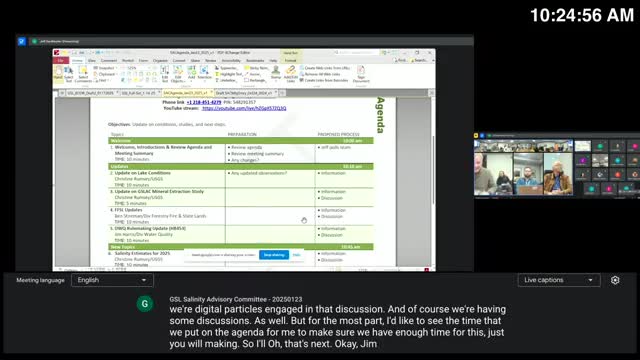State staff outline proposed discharge rule, seek salinity committee input on a 'de minimis' exception
January 25, 2025 | Utah Great Salt Lake Advisory Council, Boards and Commissions, Organizations, Utah Executive Branch, Utah

This article was created by AI summarizing key points discussed. AI makes mistakes, so for full details and context, please refer to the video of the full meeting. Please report any errors so we can fix them. Report an error »

State staff summarized progress on a draft rule that would restrict discharges to the lake when salinity exceeds a stated threshold and said they plan to publish the rule for formal comment after an interim public input round.
"Essentially, putting a prohibition on any discharges to the lake when the lake is over a 150, ramps per meter," the staff presenter said, describing draft language under development (transcript wording reflects staff phrasing of the numeric threshold).
The draft also includes a director‑discretion clause to allow limited, planned "de minimis" discharges that do not "appreciably change the concentration of the lake," the presenter said. Staff and committee members discussed approaches for defining "de minimis," including a matrix tied to lake level, volume and concentration and an associated guidance document to explain implementation in permitting.
Committee members noted voluntary industry agreements already in place with several mineral operators and said the rule should align with those agreements while providing regulatory certainty. Industry and agency representatives described two different discharge profiles: lower‑volume, lower‑salinity plant‑site discharges (daily operations) and larger‑profile pond or mineral‑return discharges that can be seasonally delayed.
Staff described a proposed schedule: internal revisions and informal comment by the end of the month, Board review in late March, publication in the register on April 1 for a 30‑day formal public comment period, and an aim to finish rulemaking by the end of June. Committee members agreed additional working‑group sessions and at least one focused committee meeting before March would be needed to provide input on definition choices and implementation guidance.
Committee direction recorded in the meeting: form a short working group to draft de minimis definitions and metrics, meet in February or early March to review initial informal comments, and reconvene the full committee in April for a broader review and runoff update.
No formal vote on the rule text was taken at the meeting; staff requested written comments on the draft schedule and language and volunteers for the working group.
"Essentially, putting a prohibition on any discharges to the lake when the lake is over a 150, ramps per meter," the staff presenter said, describing draft language under development (transcript wording reflects staff phrasing of the numeric threshold).
The draft also includes a director‑discretion clause to allow limited, planned "de minimis" discharges that do not "appreciably change the concentration of the lake," the presenter said. Staff and committee members discussed approaches for defining "de minimis," including a matrix tied to lake level, volume and concentration and an associated guidance document to explain implementation in permitting.
Committee members noted voluntary industry agreements already in place with several mineral operators and said the rule should align with those agreements while providing regulatory certainty. Industry and agency representatives described two different discharge profiles: lower‑volume, lower‑salinity plant‑site discharges (daily operations) and larger‑profile pond or mineral‑return discharges that can be seasonally delayed.
Staff described a proposed schedule: internal revisions and informal comment by the end of the month, Board review in late March, publication in the register on April 1 for a 30‑day formal public comment period, and an aim to finish rulemaking by the end of June. Committee members agreed additional working‑group sessions and at least one focused committee meeting before March would be needed to provide input on definition choices and implementation guidance.
Committee direction recorded in the meeting: form a short working group to draft de minimis definitions and metrics, meet in February or early March to review initial informal comments, and reconvene the full committee in April for a broader review and runoff update.
No formal vote on the rule text was taken at the meeting; staff requested written comments on the draft schedule and language and volunteers for the working group.
View full meeting
This article is based on a recent meeting—watch the full video and explore the complete transcript for deeper insights into the discussion.
View full meeting

